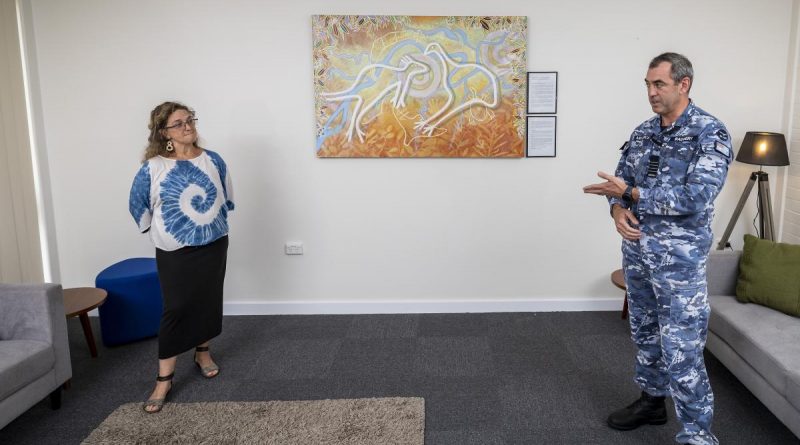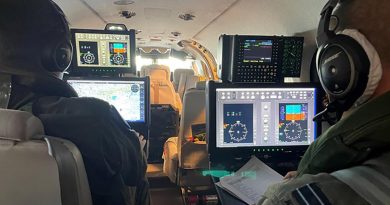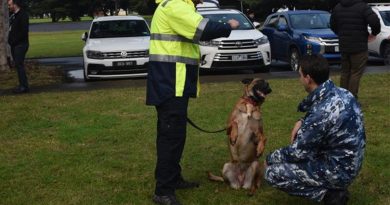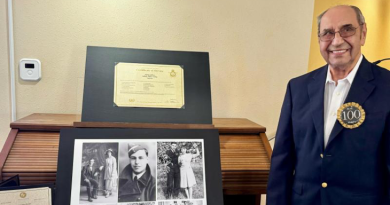Kangaroo and emu together at Richmond

Totems of the Dharug nation and Defence are proudly displayed together in an artwork commissioned by the Air Lift Systems Program Office (ALSPO).
CAPTION: Group Captain James Badgery thanks artist Leanne Tobin, of the Buruberongal and Wumali clans of the Dharug, for her artwork that will hang in the Mirrung Room at the Air Lift Systems Program Office, RAAF Base Richmond. Story by Eamon Hamilton. Photo by Corporal Dan Pinhorn.
Unveiled at RAAF Base Richmond on February 28, the artwork was created by Dharug artist Leanne Tobin following close collaboration with ALSPO’s workforce.
The artwork shows local geography including the nearby Hawkesbury River (Dyarubbin) and campsites of the Buruberongal clan of the Dharug nation.
Also depicted are examples of Buruberongal art, totems, food sources and medicine.
“At the time of writing, the Dyarubbin (Hawkesbury/Nepean River) is in full force, in a powerful display of her dominance over this terrain,” Ms Tobin said.
“This is the ‘life blood’, the main theme if you will, of this place – this is a river place.”
An explanation of Dharug symbols and values is presented alongside the artwork, along with a history of the Buruberongal being driven from their land by the colonial settlement.
“Bringing the elements represented in the artwork was a relatively easy task as I always link it back to representing the stories of place and truth-telling about past conflicts,” Ms Tobin said.
“This artwork was always going to be about my people, the Buruberongal and relating the layered histories of their homelands upon which the Defence base is located.
“For those people who have since moved onto Buruberongal Ngura (Country), learning about the past and understanding the knowledge held within the landscape, is important as it helps inform those involved in making decisions that will possibly affect this place in the future.
“It’s a way of showing respect for Country and for our people.
“Displaying a willingness to righting past wrongs by fully understanding and acknowledging those past events and actively working towards positive change, will hopefully ensure they don’t happen again.”
Ms Tobin’s maternal grandmother was descended from Buruberongal and Wumali clans of the Dharug, but kept her ancestry hidden for fear that her children could be taken and her family would be discriminated against.
Coincidentally, Ms Tobin’s parents were both ex-serving Air Force members, with her brother leading a smoking ceremony for the artwork’s unveiling.
Prominently displayed in the artwork are the kangaroo and emu – known as ‘Buru’ and ‘Mariong’ in Dharug.
“Buru is a defender – he is strong and a great protector of his people and an important totemic figure to the Buruberongal,” Ms Tobin said.
“Mariong is a Creator Spirit that cares for Country, and at night she is seen as the Dark Emu that crosses the southern skies, and according to her location, tells of seasonal changes that signify available food sources.
“A local Dreaming story tells of Mariong, who sat in a river. Standing up she shook the water from her feathers, creating the stars, with Mariong rising up to become the Milky Way.”

CAPTION: Group Captain James Badgery takes part in a smoking ceremony at the Air Lift Systems Program Office, RAAF Base Richmond. Photo by Corporal Dan Pinhorn.
These Dharug stories correspond with many of Defence’s own associations with the animals.
All Air Force aircraft display a kangaroo roundel, and the emu has been a symbol of engineering at RAAF Base Richmond since No. 2 Aircraft Depot received its unit badge in the 1940s.
ALSPO retains the emu as its symbol, and carries the legacy of engineering support at RAAF Base Richmond through its sustainment of Air Force’s C-130J Hercules and C-27J Spartan fleet.
Officer Commanding of ALSPO Group Captain James Badgery said the artwork had layers of meaning through intertwining several layers.
“The intent is that upon initial viewing, the observer will be struck by motifs and structure depending on their own history,” Group Captain Badgery said.
“Aircrew will see the geography around RAAF Richmond as if from the air, while engineers and logisticians may see the motifs of a kangaroo and emu, which are symbolic of many meanings.
“The artwork also contains symbols of sacred sites around Richmond, of history of trauma, and hope of reconciliation for the present and the future.”
Group Captain Badgery said the kangaroo and emu are also presented in the fashion of the Australian Coat of Arms on the artwork.
“The brief was to join together the three ALSPO themes of defending our country, defending our people, defending our nation,” Group Captain Badgery said.
“The intent was to reflect a single team of Air Lift from industry, Capability Acquisition and Sustainment Group, and Air Force working together for a single objective as to why we exist.
“We hope it unites people in a common purpose as a common people in a common nation.”
The artwork is displayed in a new meeting space called the ‘Mirrung Room’, which takes its name from the Dharug word for ‘belonging’ and is intended for use by Defence and industry alike.
“The Mirrung Room is a place of working together for a common cause, greater than our individual organisational differences,” Group Captain Badgery said.
“By understanding the past, we hope this room will also allow for people to consider what actions we can take to reconcile.
“That might be for industry to create jobs, or for us to create opportunities to fight through glass ceilings of entry for Indigenous Australians in pathways through Defence and industry.”
.
.

.
.





